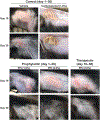Topical Esomeprazole Mitigates Radiation-Induced Dermal Inflammation and Fibrosis
- PMID: 31415221
- PMCID: PMC6876297
- DOI: 10.1667/RR15398.1
Topical Esomeprazole Mitigates Radiation-Induced Dermal Inflammation and Fibrosis
Abstract
Radiation therapy is a mainstream strategy in the treatment of several cancer types that are surgically unresectable. Unfortunately, cancer patients often suffer from unintended consequences of radiotherapy, including the development of skin inflammation (dermatitis), which may progress to fibrosis. These morbid complications often require interruption of radiotherapy and threaten the relapse of underlying cancer. Current treatment options for radiation dermatitis are suboptimal and compel the need to develop safer, more effective therapies. In this study, we assessed the biophysical properties of topically-formulated esomeprazole (here referred to as dermaprazole) and performed proof-of-concept studies to evaluate its efficacy in vitro and in vivo. We found that dermaprazole induced nuclear translocation of erythroid 2-related factor 2 (Nrf2) and significantly upregulated heme oxygenase 1 (HO1) gene and protein expression in a 3D human skin model. Our animal study demonstrated that dermaprazole improved macroscopic appearance of the irradiated skin and accelerated healing of the wounds. Histopathology data corroborated the photographic evidence and confirmed that both prophylactically and therapeutically administered dermaprazole conferred potent anti-inflammatory and antifibrotic effects. Gene expression data showed that dermaprazole downregulated several pro-oxidant, pro-inflammatory and profibrotic genes. In conclusion, topical formulation of the FDA-approved drug esomeprazole is highly effective in attenuating dermal inflammation and fibrosis.
Figures






References
-
- Mendelsohn FA, Divino CM, Reis ED, Kerstein MD. Wound care after radiation therapy. Adv Skin Wound Care 2002; 15:216–24. - PubMed
-
- Chen YP, Tsang NM, Tseng CK, Lin SY. Causes of interruption of radiotherapy in nasopharyngeal carcinoma patients in Taiwan. Jpn J Clin Oncol 2000; 30:230–4. - PubMed
-
- McCloskey SA, Jaggernauth W, Rigual NR Hicks WL Jr, Popat SR, Sullivan M, et al. Radiation treatment interruptions greater than one week and low hemoglobin levels (12 g/dL) are predictors of local regional failure after definitive concurrent chemotherapy and intensity-modulated radiation therapy for squamous cell carcinoma of the head and neck. Am J Clin Oncol 2009; 32:587–91. - PubMed
Publication types
MeSH terms
Substances
Grants and funding
LinkOut - more resources
Full Text Sources

